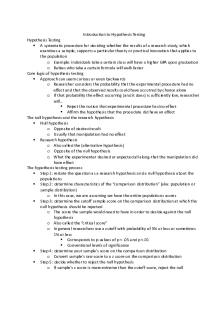Ch 5 ppt - Lecture notes chapter five PDF

| Title | Ch 5 ppt - Lecture notes chapter five |
|---|---|
| Author | Briana Taylor |
| Course | Applied Social Statistics |
| Institution | University of Central Florida |
| Pages | 2 |
| File Size | 44.3 KB |
| File Type | |
| Total Downloads | 104 |
| Total Views | 170 |
Summary
introduction to hypothesis testing...
Description
Introduction to Hypothesis Testing Hypothesis Testing A systematic procedure for deciding whether the results of a research study, which examines a sample, supports a particular theory or practical innovation that applies to the population o Example: individuals take a certain class will have a higher GPA upon graduation o Babies who take a certain formula will walk faster Core logic of hypothesis testing Approach can seem curious or even backwards o Researcher considers the probability that the experimental procedure had no effect and that the observed results could have occurred by chance alone o If that probability the effect occurring (and it does) is sufficiently low, researcher will… Reject the notion that experimental procedure had no effect Affirm the hypothesis that the procedure did have an effect The null hypothesis and the research hypothesis Null hypothesis o Opposite of desired result o Usually that manipulation had no effect Research hypothesis o Also called the (alternative hypothesis) o Opposite of the null hypothesis o What the experimenter desired or expected all along-that the manipulation did have effect The hypothesis testing process Step 1: restate the question as a research hypothesis and a null hypothesis about the populations Step 2: determine characteristics of the “comparison distribution” (aka: population or sample distribution) o In this case, we are assuming we have the entire populations scores Step 3: determine the cutoff sample score on the comparison distribution at which the null hypothesis should be rejected o The score the sample would need to have in order to decide against the null hypothesis o Also called the “critical score” o In general researchers use a cutoff with probability of 5% or less or sometimes 1% or less Corresponds to p-values of p < .05 and p...
Similar Free PDFs

Chapter 5 - Lecture notes ch 5
- 6 Pages

PPT-5 - Lecture notes 2
- 12 Pages

BA3350 CH 5 - Lecture notes CH 5
- 17 Pages

5- seepage 2D PPT - Lecture notes 5
- 38 Pages

Ch 31 - Lecture notes 5
- 28 Pages

Chapter 5 - Lecture notes 5
- 15 Pages

Chapter-5 - Lecture notes 5
- 6 Pages

Chapter 5 - Lecture notes 5
- 83 Pages

Chapter 5 - Lecture notes 5
- 4 Pages

Chapter 5 - Lecture notes 5
- 20 Pages

Chapter 5 - Lecture notes 5
- 4 Pages

Chapter 5 Lecture Notes
- 11 Pages

Chapter 5 - Lecture notes 5
- 7 Pages

Chapter 5 - Lecture notes 5
- 2 Pages
Popular Institutions
- Tinajero National High School - Annex
- Politeknik Caltex Riau
- Yokohama City University
- SGT University
- University of Al-Qadisiyah
- Divine Word College of Vigan
- Techniek College Rotterdam
- Universidade de Santiago
- Universiti Teknologi MARA Cawangan Johor Kampus Pasir Gudang
- Poltekkes Kemenkes Yogyakarta
- Baguio City National High School
- Colegio san marcos
- preparatoria uno
- Centro de Bachillerato Tecnológico Industrial y de Servicios No. 107
- Dalian Maritime University
- Quang Trung Secondary School
- Colegio Tecnológico en Informática
- Corporación Regional de Educación Superior
- Grupo CEDVA
- Dar Al Uloom University
- Centro de Estudios Preuniversitarios de la Universidad Nacional de Ingeniería
- 上智大学
- Aakash International School, Nuna Majara
- San Felipe Neri Catholic School
- Kang Chiao International School - New Taipei City
- Misamis Occidental National High School
- Institución Educativa Escuela Normal Juan Ladrilleros
- Kolehiyo ng Pantukan
- Batanes State College
- Instituto Continental
- Sekolah Menengah Kejuruan Kesehatan Kaltara (Tarakan)
- Colegio de La Inmaculada Concepcion - Cebu

